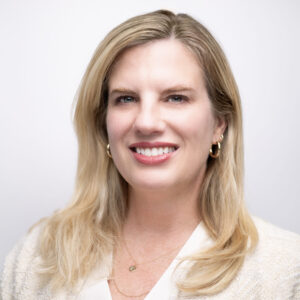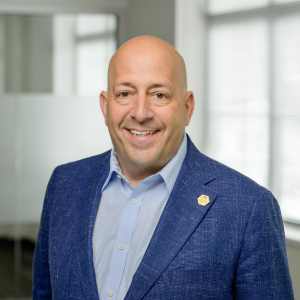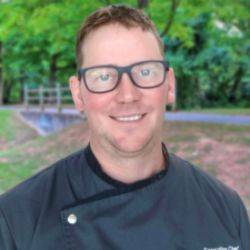Rolling Fields wins 2009 OPTIMA Award
Editor’s note: This month’s cover feature in our print magazine details how Rolling Fields of Conneautville, Pennsylvania, transformed their culture change journey by instituting 24-hour dining for elders. Below is the original entry form that goes into greater detail on how this skilled nursing home accomplished such a major change.
I. Introduction
| Editor Maureen Hrehocik interviews Kim Moody and Cindy Godfrey, owners of Rolling Fields. |
Rolling Fields is a skilled nursing home, owned and operated by the second generation of Braham family members, Kim Moody and Cindy Godfrey. Through the years, this family has stood behind the idea that Elders are a valuable asset to our community and have made each Elder that came through their doors a part of their family. Rolling Fields follows the Eden Alternative Philosophy for nursing home culture change. Our philosophy centers on building relationships and introducing variety, spontaneity and companionship into daily life.
The program Rolling Fields presented for the 2009 OPTIMA Award is our 24-hour dining service known to us as “Jump Off The Cliff.” We began work on this program in March of 2007 and fully implemented the program in December of 2008.
II. Problem
In early 2007, as Kim Moody, our Administrator and part owner, was helping pass breakfast trays to the Elders in our home, she realized that she had to wake the majority of them up in order to let them know it was time to eat. After spending the previous several years advocating for Elder choices and educating our home on culture change, she had another light bulb moment as we have come to call them. In order to truly allow Elders that choose to dine in their rooms an option of sleeping in and picking their own meal times, we would have to completely get rid of the institutional tray service. This was huge. She approached the Leadership Team and described that she felt like she was on the edge of a cliff, and the only way to completely be free to let Elders choose when they got up, ate, and spent their day was to “JUMP OFF THE CLIFF” as we named it.
For many years food complaints had been brought up in care plan meetings, Elder council meetings, Elder satisfaction surveys, DOH surveys, and the majority of our staff packed their meals. We all know that food is central to our lives especially to Elders with limited physical abilities. Nutrition affects every area of an Elder’s physical and mental well being from skin and medications to their general mood and happiness. In a traditional nursing home the entire institution must plan all schedules around the delivery of tray service. There can be no Elder freedom of choice with that much structure in your day, therefore true culture change can not take place.
III. Planning
“Jump Off The Cliff” or JOTC for short, soon became a common name to the Caregivers and Elders in our home. Leadership met to determine how and when to proceed with this enormous life-altering idea. The first rounds of educational “Jump” meetings were held for our entire staff. Each meeting was solely to communicate and put the idea out to everyone. At the completion of these first meetings we posted sign -up sheets for those interested in helping us to bring about this new way of life to our home. The first team of JOTC’ers was formed from this list under the guidance of the Leadership Team. This first group was selected from those who volunteered their time “off the clock” to work through all the scenarios and possibilities that would bring this idea to fruition.
This group began with its first official meeting in March of 2007. Meeting weekly for sessions of 2-3 hours, these volunteers took on the daunting task of sorting through all the pieces that needed changed as we made this culinary transformation. It was not long before they had indentified the need to change the way we did most everything in our home. The group spent week after week redefining job descriptions, indentifying daily chores and tasks, discussing medication management, formulating a menu based on Elder requests, developing an Elder interview and story, redesigning our pantries, and realizing the need for independent team scheduling. They toured other types of facilities to look at dining options and the possibilities that we might bring to the Elders in our home.
Ultimately, this group of 30 volunteers from each discipline and representative of each care team house-wide would pave the way with a new way of life for everyone living and working in our home. After months of working through all the scenarios on paper, they prepared for a pilot that would trial every aspect from team scheduling as a 24-hour care team to serving meals round the clock. The team recognized the need for more education not only for our remaining staff members, but our Elders and their families. Each member of the team presented a piece of the puzzle at two open house events, sharing their ideas, food samplings, and an overview of what was to come.
The day came to put all the ideas to work. The next chore would be choosing a street to pilot the program. After much deliberation and some input from Eden Leadership, the team chose a street with a large sampling of Elders that dined in-room as well as a mixed population with regard to acuity (Elders needing dining assistance.) A pilot kitchen was constructed in an unused office space, and the pilot date was set for August 2007.
The pilot ran for two months before realizing the need to add a second neighboring street. The JOTC team took the opportunity to test their training and communication skills as they prepared a new team for the “Jump”. In October of 2007 this 2nd team made the “jump” to become another milestone on our journey. Six months later, after working through the kinks and implementing changes in how work is done and life is lived, a new culture evolved and we began to hire new Caregivers where we once had housekeepers and hospitality aides. Each member of our care team became a more “universal” worker, taking on duties of daily house chores. Elders reaped the benefits of sleeping in, going to bed when they chose, ordering what they wanted from a made-to-order menu whenever they wanted. Caregivers worked together to fill the 24-hour needs on their streets. As the transformation unraveled this exciting way of life, other care teams were eager to participate.
The idea of “hop” came to play as we completed renovations to our pantries and our once institutional kitchen became a restaurant kitchen. In March of 2008 we added two more of our six streets to the “hop”, presenting made-to-order breakfast to these two streets Elders. This trial only brought the realization of our “JOTC” vision closer and we “jumped” whole house on December 16th, 2008.
IV. Implementation
On December 16, 2008, we finally went whole house with our new dining program. To prepare for implementation, there were many areas that had to be addressed. One of our biggest, and most costly, obstacles was the fact that we had the perfect kitchen for making and serving large batches of institutional food. We did not have a kitchen that would work well for restaurant style service. Therefore, we had a company consult for a kitchen remodel. They helped us determine what equipment we needed, what equipment we currently had that we did not need, and what would be the best way to set up our kitchen. We included our Culinary Staff in this process. It was quite a change for many of them, as we have two cooks who have been with us for 30 years, and they have only done institutional cooking. However, we trained them over several weeks time prior to implementation. We also recognized that some of the training had to take place on the fly because you cannot predict what will happen when the orders start coming in. Training was accomplished with the help of several staff members who did have restaurant experience.
Menu development was also a lengthy process. This was done mostly by Allyson DeVantier, our Registered Dietician, Cindy Godfrey our Quality Assurance Director and part owner, and our Culinary Staff. Menu development started with Elder interviews. The jump team worked together to interview Elders and find out likes and dislikes. They asked specific yes/no questions, but they also asked open-ended questions e.g. are there items not on our current menu that you would like to have on the menu? Once the surveys were completed, a 24-hour menu was developed. This menu was also developed based on results from the pilot program. During the pilot, we kept track of what items were popular and what items were not. We also kept track of requests. In fact, the menu was modified as least twice during the pilot based on those results. When developing the 24-hour menu, ease of cooking, speed of cooking, and ease of holding were also considered.
We knew that we had to keep the menu fresh. Therefore, we came up with the idea of daily specials. Ultimately, we decided on 2 specials each day which would be available from 11:00am through 7:00pm. If the Elders were not interested in the specials or what to eat outside of these times, they would have the 24-hour menu available to them as well. The specials were set up as an entrée and a side; however, mixing and matching is allowed. Generally, one entrée comes with a starch, and one entrée comes with a vegetable.
Once the menus were completed, we had to figure out how much food we needed to order. This presented a whole new challenge since we were used to working off of a cycle menu that only changed twice a year. Now we were going to have not only two specials a day, but also a vast number of other items that had to be available at all times. At first, ordering was trial and error. Essentially, we did some educated guessing based on the surveys we had completed and on past history. Luckily, once we got started, our Micros Point of Service (POS) system was able to track everything ordered and after about a month we were able to start tweaking our orders based on actual order history. We did have some extra inventory, but we were able to tailor our specials to use it.
Our next challenge was deciding what to do with pantries we had throughout our home. The pantries had already gone through several changes. We had removed the doors several years ago, added soup crocks and juice machines, and tried to make them more accessible to the Elders. However, we recognized that now that food would be available from the kitchen 24 hours a day, we did not need so many items in the pantries. We decided to use them as beverage stations. We made it possible for toast and cold cereal to be made there, and they became the bussing areas for room service. In order to accomplish this, we had to expand three of our four pantries since we had to add a milk machine, a coffee machine, and ice. In addition, we knew the traffic would increase, and the current pantries were barely big enough for two people. Pantries are complete with ice storage, a refrigerator, a sink and cupboard space for cups and saucers, silverware, small plates, and cereal bowls. We also store our linens in the pantries that are needed for room service.
Like many homes we have struggled with how to offer a dignified dining experience for our Elders who require assistance with their meals. For many years, they were taken to the dining room, but we felt like we were feeding a herd of cattle. Then, we established “feeding areas” throughout our home and opened the dining room to only Elders who were independent with their meals. That ultimately ended up being no more dignified than taking them all to the dining room. Now that we had 24-hour dining, we realized that we could offer room service to our Elders who need assistance with meals. In doing this, our Elders are no longer rushed, and they receive 1:1 assistance. However, to accomplish this, we needed to change the roles of some of our staff. Most notably, we combined housekeepers and hospitality assistants, and instead we now have Caregivers. Caregivers are responsible for many of the chores that need to be accomplished in our home, but they also play a large role in helping with dining. All Staff in our home are certified feeding assistants; therefore, anyone can sit down and assist an Elder with his/her meal.
Making the change from housekeeper/hospitality assistant was difficult for some staff members. We actually had a couple housekeepers who chose to retire rather than make the transition, and one changed departments. However, many more made the transition and are thriving in their new roles. One of our culinary Caregivers changed departments because she wanted to be a Caregiver on the street. As we hired new Caregivers, we immediately trained them in the “new way” of doing things even prior to going whole house with dining. One of the Caregivers who had worked on the pilot program spent several weeks on each street training the staff on how to be a Caregiver.
Once we had the Caregivers in place, we were finally able to offer the room service experience we desired. Over-the-bed table linens were custom made for us. Any Elder who eats in their room, either by choice or because they need assistance, has their over-the-bed table set for them with linens. They receive their beverages while they wait for their food. Their food arrives with mini glass salt and pepper shakers and whatever condiments the Elder ordered. Trays are used for delivery and bussing only, and we also ordered silver (non-institutional) plate covers to add to the experience even more. Mandatory training sessions were held for all staff on the standard for room service presentation.
Several months into the pilot after taking orders on paper, we realized that we needed a computerized system for placing orders. At the beginning of the pilot program, we had set up a temporary kitchen in a large office at the end of the streets that were in the pilot. Because of the close proximity, staff were able to hand deliver their orders. All staff carried beepers, and the cook paged them when their food was ready. This worked well for 2 streets and 60 Elders, but we recognized that it would not work for 6 streets and 180 Elders. We contemplated many options from setting up our own computer system using Access (which is what we did for the streets ordering only breakfast) to having someone man the phone in the kitchen and take orders. Finally, we settled on purchasing a POS software system that is used in restaurants. However, the system had to be tailored to us. Restaurants do not have the same customers everyday that you need to keep track of. We needed a way to have all of our Elders in the system, and we needed to be able to keep track of their meals to ensure that everyone ate. Therefore, after much work on the part of their programmer, we began using the Micros POS system for the pilot program in May 2008. At this point, we also were able to carve out an area in our main kitchen for the pilot program, and we closed our temporary kitchen. Using this program made a lot of things easier. The Caregivers were able to place orders from the street, and it immediately was sent to the kitchen. They were also able to see when the orders were ready so that they knew when to pick them up. We were able to record meal percentages using this system, and to start some preliminary tracking of the popularity of menu items. Because it was custom-made, some glitches did have to be worked out, so it was very helpful that it was included in the pilot program.
The participation and support that we received for implementing our new program was astounding. Our administrator, Kim Moody stepped out of her role as administrator because she recognized that proceeding with culture change full force was a full time job in itself. So, in January 2008, she handed the reins over to her assistant administrator, Aaron Praetzel. In addition, our entire Leadership Team, which consists of 14 people, committed themselves to helping with this process. They were involved in everything from covering the streets so that mandatory meetings could be held, educating staff, helping to problem solve, and communicating with their staff and other members of Leadership. Entire Care Teams combined and worked together to step out of their traditional roles and everyone became a Caregiver. In order for everyone to become a Caregiver, we worked together to make everything more accessible. We put bleach wipes on all streets and in all Elders’ bathrooms so that anyone can easily wipe down an over-the-bed table or bathroom. We opened up the janitors’ closets and left the chemicals locked in cabinets with an easily accessible key, so that anyone can have access to the items they need. We train all staff on how to use the extractor because anyone can clean up a spill.
When it comes right down to it, the physical changes that we made were the easiest part. The hard part was changing the mindset of Staff and Elders and retraining every Staff member in our home to look at their jobs in a different way. The Staff had to start offering our Elders choices for their meals. It was no longer just giving an Elder the same beverage everyday because that’s what they liked the day before. Not only did the Elders need choices of menu items, but also of the times that they ate. Meals are now available 24 hours a day, so Elders do not have to be stuck in the rut of breakfast, lunch, and dinner at the same time every day. However, it was not just Staff who had to change. Many Elders were so used to the institutional routine; it was hard to convince them that the kitchen would not run out of food if they were not in the dining room by 5:00pm. It is easier with Elders who have come to live with us since we made the change because they never knew any other way. We had to train Staff how to provide choices to Elders who could not communicate. This is done through family interviews and through trial and error. Each Care Team has come up with a different way to track likes and dislikes. Some Care Teams keep lists, and some Care Teams just communicate with each other verbally. Also, using the POS system, Caregivers can look back and see what an Elder ate for their previous meal. This prevents them from receiving the same meal over and over again. Education is ongoing when it comes to culture change, and the Leadership Team is committed to continually educating their streets and continuing our journey.
V. Evaluation
Our new 24-hour dining has had a huge impact on the lives of our Elders, staff and families. Quality of life for our Elders has been improved greatly because they now may choose exactly what and when they want to eat. There is no mad rush in the morning to get Elders up for their breakfast trays. Elders are sleeping in if they wish and we are able to allow them to maintain the same daily routine as they had at home. Our Elders’ physical health is also benefitting from this change. One of the most notable impacts has been a substantial decrease in the number of Elders on puree diets. We have typically had 20 to 30 Elders on puree. Because of the selection of food available and because there is more time for one on one interaction with dining, we only have seven Elders remaining on a puree diet. Another notable outcome has occurred with Elders with long standing pressure ulcers. Several Elders have been healed due to their increased intake now that they are able to choose the food they want to eat. We have seen many Elders at risk for weight loss now gaining weight due to the many choices available to them. Our use of supplements has decreased dramatically. Pain and behavioral issues are improving as we are now able to help an Elder who is up during the night by serving them a meal at their request, not just a typical snack item. Finally, Elder satisfaction with our home has been greatly impacted. Care plan meetings and resident council no longer revolve around the focus of food issues instead they are filled with compliments on the changes we have made. At our annual state survey in May, there were no Elder complaints about food. In fact, there were many glowing reviews about the food service not only from our Elders but also from the state surveyors, who ordered lunch each day of the survey. There have been no complaints about food temperatures as all meals are freshly made to order. Dining has become an event in our home and more Elders than ever are choosing to come out of their rooms and enjoy our dining room. Those that choose to eat in their rooms have commented on how much nicer our room service is than the institutional tray they used to receive.
Our meal sales to staff and families have gone from about $2,000 per month to $6,400 per month. There has been such a demand from families wanting to eat with their Elders that we have hired a hostess to seat and take reservations. The increase in visitors has had a positive impact on our Elders who love to take their family and friends out to dinner at our restaurant.
Our staff members have also benefited from our new dining. Caregivers have more time to give Elders a positive dining experience which has increased job satisfaction. Many staff members have noted the positive impact the new dining has had on their Elders’ health and well being. Our staff members are also able to order a hot meal at an economical price, which is a great benefit in this economy.
CMS nursing home guidance is focusing on resident quality of life, environment and choice. One area to be reviewed during survey is looking for homes to de-institutionalize their meal service. Elder-centered care can truly not happen until this is accomplished. Our success proves that this can and should be done. Our Elders deserve nothing less. Our culture change journey can now flourish unimpeded with the boundaries of institutional food service.
I Advance Senior Care is the industry-leading source for practical, in-depth, business-building, and resident care information for owners, executives, administrators, and directors of nursing at assisted living communities, skilled nursing facilities, post-acute facilities, and continuing care retirement communities. The I Advance Senior Care editorial team and industry experts provide market analysis, strategic direction, policy commentary, clinical best-practices, business management, and technology breakthroughs.
I Advance Senior Care is part of the Institute for the Advancement of Senior Care and published by Plain-English Health Care.
Related Articles
Topics: Articles , Nutrition











